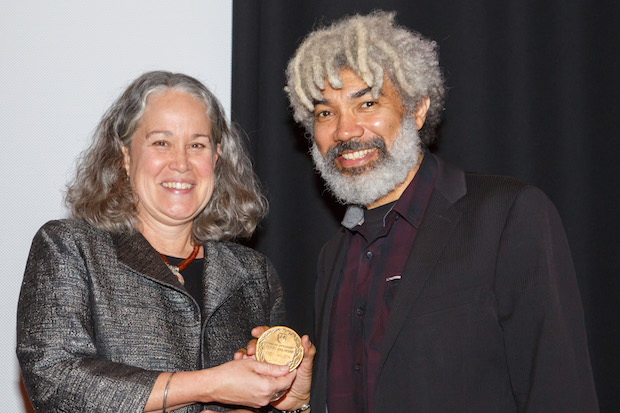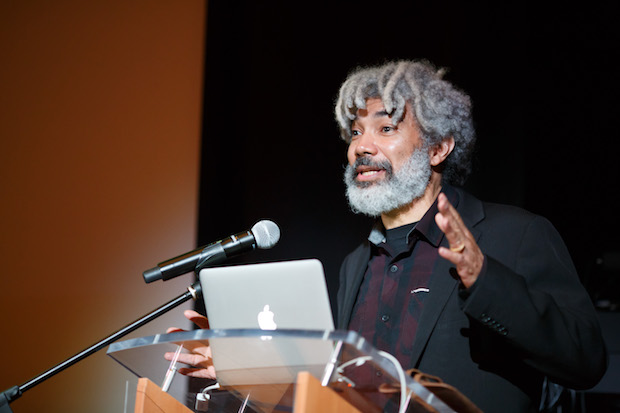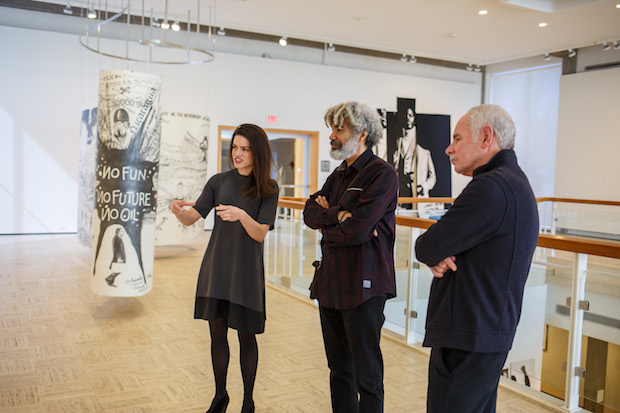Fred Wilson: training our gaze on the unseen
Visual artist presented with Creative Arts Award
 Photo/Heratch Ekmekjian
Photo/Heratch EkmekjianSchool of Arts and Sciences dean Dorothy Hodgson presents Fred Wilson with the Creative Arts Award Medal
Fred Wilson has spent a lifetime in art surfacing the previously buried, hidden or ignored.
He discussed his artistic path in a lecture, followed by questions from the audience on Tuesday March 3, as he accepted Brandeis’ biennial Creative Arts Award at the Wasserman Cinematheque.
Dean of Arts and Sciences Dorothy Hodgson introduced Wilson as “a stellar artist whose pathbreaking work combines everything Brandeis aspires to be and become,” before giving him the award.
Wilson’s keen eye for what museums and their patrons see and how they see it – particularly related to the absence of people of color and their perspectives – began to be honed during college at SUNY Purchase, when Wilson spent hundreds of hours inside museums working as a guard. “It was quite fascinating to me…when you’re a guard you’re basically on display like every other object, but you’re also invisible. And this kind of strange dichotomy always stayed with me.”

Wilson gave a talk following the award presentation.
He recalled being invited to speak to docents and other staff at New York’s Whitney Museum of American Art. After a lunch, he asked the museum staff members to meet him in front of an exhibit he had been asked to interpret, telling them he would be in costume. He changed into a museum guard uniform and stood next to a sign reading “Fred Wilson Speaks” at the exhibit he was scheduled to discuss. The staff gathered and never recognized that he was there until he spoke up.
“You put on the uniform and you disappear,” he said.
After college he worked in the education departments of several museums, including the Metropolitan Museum of Art and the American Museum of Natural History. Sometimes he worked at both museums in the same day, crossing Central Park to get from one job to the other.
“I’ve come to know museums pretty well, and knowing them is to love them, but also it made me want to critique them” he said, “There were many questions I had about how they interpreted things.”

Wilson on a tour of the Rose Art Museum with museum staff
Wilson’s watershed exhibition came in 1992. In “Mining the Museum” at Baltimore’s Maryland Historical Society, Wilson famously juxtaposed historic objects associated with the white middle- and upper-class with contemporary pieces related to slavery and white supremacy.
One exhibit titled “Metalwork 1793-1880” displayed slave shackles surrounded by elaborate repoussé silver dining pieces, linking the material possessions of wealthy Marylanders directly with the agony endured by enslaved people. Another arranged antique chairs ranging from the highly decorative to the simply functional facing a wooden whipping post.
He placed the museum’s busts of Henry Clay, Andrew Jackson and Napoleon on pedestals opposite three empty pedestals labeled Harriet Tubman, Benjamin Banneker, and Frederick Douglas, “all three African Americans very important to the nation, all from Baltimore Maryland, and nothing about them in the Maryland Historical Society.”
Wilson continued to examine other U.S. museums and the items they didn’t display. He also mounted major international exhibitions, including representing the United States with a solo exhibition at the 50th Venice Biennale in 2003, and participating in the Istanbul Biennial in 2017. He spoke about both in his talk, and about the emphasis he put on highlighting hidden figures of Africans and African descendants in both shows.
Wilson spent several intensive days at Brandeis, visiting art history and studio art classes and engaging with students informally, during meals and individual studio visits. He also visited the Rose Art Museum exhibitions and storage spaces, the Library Archives and Special Collections, and closely interacted with faculty and students from the Division of Creative Arts, and African and African American studies. Wilson will return later in March to continue the residency that is part of the Creative Arts Award.
“Fred’s brilliant art, generosity and inspiring spirit made the first part of his residency on campus a resounding success, said Gannit Ankori, Professor of Fine Arts and Women, Gender and Sexuality Studies, who took the lead in organizing Fred Wilson’s Creative Arts Award residency. “We feel extremely privileged to have had the opportunity to learn about his artistic oeuvre and to glean insights about the work from the artist himself. Next time Fred comes to campus, he plans to share his upcoming projects with our community, perhaps even to conduct research on works-in-progress with our students and our library taking part in this creative process.”
Launched in 1956, the Brandeis Creative Arts Award has been presented to scores of the most distinguished artists, art scholars, dancers, filmmakers, theater performers and writers of the 20th century. Visual artists include Stuart Davis, Alexander Calder, Ellsworth Kelly, Georgia O'Keeffe, David Smith, Mark Rothko, Isamu Noguchi, Frank Stella, Joseph Cornell, Jasper Johns, Claes Oldenberg, Joan Mitchell, Robert Morris, Tony Smith, Robert Rauschenberg, Jackie Winsor, Philip Guston, Mary Miss, and Jennifer Bartlett.
After a long hiatus, the award was reconfigured as a biennial prize in 2015, with Fred Wilson the first visual artist to receive the renewed award.





